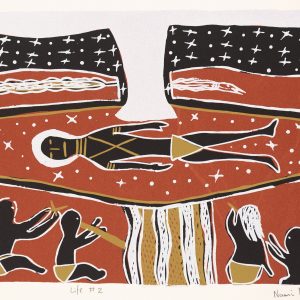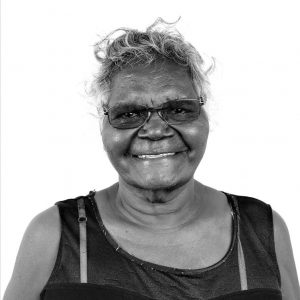Description
Details
- Medium: Screen print
- Size: 420 x 600 (image) and 660 x 840 mm (paper)
- Paper: n/a
- Edition: 95
- Published: c1989
- Studio: Desert Prints Fremantle
Subject
Jumu is like a seasonal waterhole. This jumu is in the Japingka area. The big dark trees all around are bush peanut trees. In my country there, we eat the peanuts, cook them in the fire and they open up.
Jimmy Pike Biography
Jimmy Pike was born near Jila Japingka a major waterhole around 400 kilometres south of Fitzroy Crossing in the Great Sandy Desert. Jila are desert soaks that never dry out. The word ‘jila’ is often translated by desert people as ‘living water’, indicating the importance of these sites.
Jimmy Pike first explored felt-pen drawing and linocut printing in the early 1980s. As an inmate at Fremantle Prison, Pike attended art classes organised by Stephen Culley and David Wroth, who would later establish Desert Designs and become collaborators.
Jila Japingka is a significant subject in Pike’s artwork and appears in many prints and drawings, including some of his earliest prints. Pike also created artworks depicting the spirit who lives at Japingka. Fellow Walmajarri artist Peter Pijaju Skipper has described Japingka as:
Japingka is a big jila. It’s the main waterhole for my Country; my father’s Country, my grandfather’s Country. It’s a big Law place. People used to meet there in hot weather, before rain. They did ceremonies there. I used to go there with my family when I was a boy.
Jimmy Pike – Lowe, P 2007, In the desert: Jimmy Pike as a boy, Penguin Books, Camberwell, pp 59–60.
In the late 1980s, Pike and Pat Lowe collaborated with director John Tristram to create the documentary The Quest of Jimmy Pike (1990). Filmed at Kurlku, other locations in the Great Sandy Desert and Fitzroy Crossing the documentary captures Pike’s attempts to return to Jila Japingka with members of his family who had not visited this important site for decades. Unable to make the journey by car or on foot, Pike flew there by helicopter across the desert sand hills.
In 1986 Jimmy Pike was released on parole to a desert camp with members of his family at Kurlku on the edge of his country in the Great Sandy Desert. That same year Pat Lowe, a British born psychologist who had met Pike in Broome Prison in the late 1970s, joined the artist at Kurlku as his partner and collaborator.
From 1990, until Pike passed away in 2002, the couple were based in Broome, from where they could both visit the desert and travel internationally to attend exhibitions of Pike’s art.
Acknowledgement: AIATSIS
Pike had 14 solo exhibitions between 1985 and 2001 and participated in many more group exhibitions. His works are held in collections all over the world.








